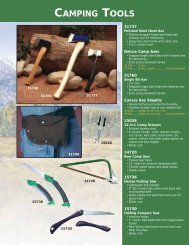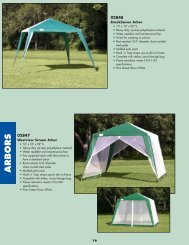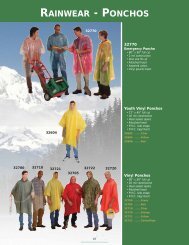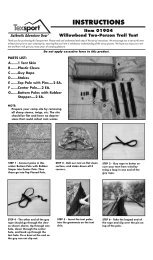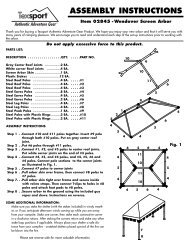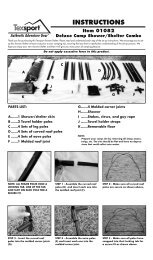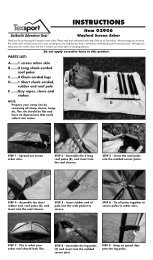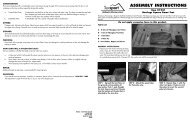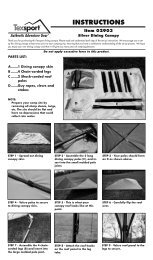INSTRUCTIONS Item 01114 Mountain Breeze Screen ... - Texsport
INSTRUCTIONS Item 01114 Mountain Breeze Screen ... - Texsport
INSTRUCTIONS Item 01114 Mountain Breeze Screen ... - Texsport
Create successful ePaper yourself
Turn your PDF publications into a flip-book with our unique Google optimized e-Paper software.
<strong>INSTRUCTIONS</strong><br />
<strong>Item</strong> <strong>01114</strong><br />
<strong>Mountain</strong> <strong>Breeze</strong> <strong>Screen</strong> Porch Tent<br />
Thank you for purchasing this <strong>Texsport</strong> tent. Please read and understand each step of the set-up instructions. We encourage you to set-up this tent<br />
at least once prior to your camping trip, ensuring that you have a satisfactory understanding of the set-up process. We hope you enjoy your new<br />
tent and that it will give you many years of camping pleasure.<br />
PARTS LIST:<br />
A ......Tent skin<br />
B ......2 Sets of porch leg poles<br />
C ......2 Sets of tent poles<br />
D......1 Porch roof pole<br />
E ......Stakes, guy ropes and<br />
clews.<br />
NOTE:<br />
Prepare your camp site by removing all<br />
sharp stones, twigs, etc. The site should be<br />
flat and have no depressions that could collect<br />
rain water.<br />
Do not apply excessive force to this product.<br />
A<br />
B C<br />
STEP 1 - Spread out tent skin. STEP 2 - Assemble poles (C) and<br />
insert through the tent sleeves.<br />
STEP 4 - Losly tie the poles at<br />
the center of the tent skin<br />
STEP 7 - This is how your tent<br />
should look at this point.<br />
STEP 5 - Insert the pin and ring<br />
into the end of the pole (C).<br />
STEP 8 - Assemble the porch<br />
roof pole (D) and insert<br />
through the porch arch sleeve.<br />
D<br />
STEP 3 - Your poles should form<br />
an X as shown above.<br />
E<br />
STEP 6 - Attach speed clips to<br />
pole frame.<br />
STEP 9 - Insert roof pole into the<br />
small opening of the attached<br />
molded corner joint.
STEP 10 - Assemble the porch<br />
legs (B) and insert into the<br />
open end of the attached<br />
molded corner joint.<br />
STEP 13 - Stake down all tabs<br />
and front door.<br />
STEP 16 - To attached the fly,<br />
drap over tent and secure with<br />
hooks into the porch legs.<br />
STEP 19 - It is recommended in<br />
windy weather to secure your<br />
tent with guy ropes. Insert the<br />
guy rope into clew as shown<br />
above.<br />
STEP 11 - Insert the pin and<br />
ring of the porch skin into the<br />
porch leg poles.<br />
STEP 14 - This is what your tent<br />
should look like.<br />
STEP 17 - Secure fly by hooking<br />
onto the rings at the pin<br />
and ring.<br />
STEP 20 - Tie the other end of<br />
the guy rope to the tabs on the<br />
fly.<br />
STEP 22 - Stake down<br />
the guy rope and adjust<br />
the tension on the guy<br />
rope by sliding the clew<br />
up or down.<br />
STEP 12 - Stake down at all the<br />
pin rings.<br />
STEP 15 - Stake down the mud<br />
mat inside porch.<br />
STEP 18 - Velcro fly to frame<br />
poles.<br />
STEP 21 - Loosen the guy rope<br />
as shown to wrap around a<br />
stake.<br />
STEP 23 - This is<br />
what your<br />
completely built<br />
tent should look<br />
like.
WARNING:<br />
<strong>Texsport</strong> tent fabrics are flame retardant treated per C.P.A.I.-84 specification. However, for your safety, we recommend that<br />
NO OPEN FLAME BE USED IN OR NEAR YOUR tent.<br />
SOME ADDITIONAL INFORMATION:<br />
Make sure you stake the tent (with the tent stakes included) in windy weather, or if you anticipate afternoon winds coming up<br />
while you are away from your campsite. Stake one corner, then stake each consecutive corner in a clockwise rotation. Make<br />
sure the tent remains tight. Always place your tent a safe distance from your campfire - unstaked tent placed upwind of the<br />
fire can be blown into the fire. Tent placed downwind of the fire are often showered with tiny sparks that can burn holes into<br />
the lightweight fabrics of your tent.<br />
WATERPROOFING YOUR TENT:<br />
<strong>Texsport</strong> tents are made from coated water-repellent fabrics. However, the sewing process, necessary in all tent fabrication,<br />
can cause water leakage where the sewing needles have perforated the fabric in the seams. Without treatment the tent will<br />
leak. Every new tent needs to be seam sealed to make it water tight. We recommend using <strong>Texsport</strong> Spray<br />
Waterproofing/Seam Sealer which may be found at your local outdoor outfitter or camping store.<br />
TENT STAKES:<br />
All tents should be staked down. The stakes supplied with your tent are effective for most conditions; however, specialized<br />
stakes are recommended in certain cases:<br />
a. Sand Stakes: ..Long broad stakes designed to hold in loose sand.<br />
b. Steel Stakes:....Most effective in hard, rocky or frozen soil. These can rust and their sharp edges could damage the tent<br />
......................if stored with the tent. In extremely hard soil a steel rod can be used to make the starter hole.<br />
c. Skewer Stakes: Lightweight, but less holding power that the standard stakes.<br />
d. Snow Stakes: ..The most common method is to bury objects with a great deal of surface area in the snow i.e. branches,<br />
......................aluminum pie plates, stuff sacks or tent bags filled with snow and buried: (this may be referred to as the<br />
......................dead man method). Tents can also be secured to snow skis or poles which are stuck into the snow.<br />
ZIPPERS:<br />
If zippers stick, lubricate with silicone. Never force a zipper which has material caught in it, as this will bend the slider<br />
and prevent the zipper from closing. Continual use in a sandy environment can cause the slider to erode and fail to<br />
close the zipper.<br />
STORAGE:<br />
Tents should be stored dry and loosely folded, away from heat and water. Keep out of reach of mice as they like to nest in<br />
tents. Never store directly on concrete, as moisture and chemicals in concrete may damage the nylon.<br />
WASHING:<br />
Hand wash with a sponge, using a mild soap. Never use detergents or washing machines as they may damage the coating or<br />
seams. remember to use seam sealer once tent had been washed to insure waterproofing.<br />
HOW LONG WILL A NYLON TENT LAST?<br />
Various conditions will affect the length of service which you receive:<br />
a. A nylon tent which is left erected all summer may last only one or two seasons, as the sun’s ultra-violet rays<br />
damage the nylon.<br />
b. Never store a tent wet or damp, as mildew may develop. It will not harm nylon, however, mildew is unsightly and may<br />
damage other parts of the tent (i.e. zipper tapes).<br />
c. Avoid spraying insect repellent or hair sprays, etc. on tent fabric as they may be harmful.<br />
REPAIR:<br />
For small tears use a an adhesive backed rip-stop nylon patch. We recommend <strong>Texsport</strong> Nylon Tent Repair Kit which may be<br />
found at your local outdoor outfitter or camping store.<br />
QUESTIONS:<br />
If you should have any questions, problems or comments, please call our Customer Service Department at<br />
1-800-231-1402 or e-mail info@texsport.com. This Department is open M–F from 8 a.m.–5 p.m. CST.



